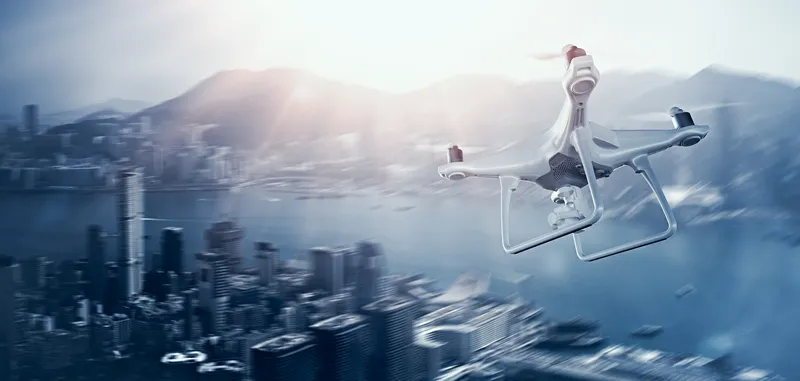A new IDTechEx report, Electric Drones: Unmanned Aerial Vehicles UAVs 2015-2025, examines the market for drones or unmanned aerial vehicles (UAVs), saying that most of the market value today lies in military applications, both for electric and - the big money - non-electric versions. Nonetheless, small UAVs are increasing in sales fastest and that is primarily down to non-military applications. From 2026, civil uses will greatly exceed military in market value. The report forecasts it all but concentrates o
February 19, 2015
Read time: 3 mins
RSSA new 6582 IDTechEx report, Electric Drones: Unmanned Aerial Vehicles UAVs 2015-2025, examines the market for drones or unmanned aerial vehicles (UAVs), saying that most of the market value today lies in military applications, both for electric and - the big money - non-electric versions. Nonetheless, small UAVs are increasing in sales fastest and that is primarily down to non-military applications. From 2026, civil uses will greatly exceed military in market value.
The report forecasts it all but concentrates on hybrid and pure electric versions because these are taking over.
Dr Harrop, chairman of IDTechEx says, "The biggest market sub-sector will be small UAVs that are not toys or personal, with US$2 billion in sales in 2025 generating over US$20 billion in benefits in agriculture, border protection, parcel delivery, logistics such as warehousing, coastguard, customs, search and rescue, medical emergency, malaria research, mine detection, protection of rare species, movie production and so on."
For example, Amazon recently reiterated that they are committed to delivering packages to customers via drones when they get the regulatory support needed. China's biggest internet retailer Alibaba trialled drone deliveries in the country at the beginning of February.1691 Google has also been testing drone deliveries in Australia, and DHL carried out deliveries by unmanned aircraft in Germany.
According to the report, new applications appear every month and it particularly concentrates on what has happened in 2014-15 and what comes next in this changing market. That includes technological change, with bodywork becoming electric and electronics to save cost, volume and weight while increasing reliability and life.
This 200 page report has over 120 figures and tables distilling the markets and technology into roadmaps and forecasts by number, unit value and market value 2015-2025. The rapidly changing powertrains, the uses, participants and benefits are discussed.
Adoption of cameras, cost reduction, types, alternatives, legal issues, latest news, new inventions from drones that walk or swim to ones proposed for garnering power - it is all here. Autonomy is addressed and the hype curve in the context of other relevant electric vehicles. Components and systems manufacturers will see the big picture with the full opportunity drone makers and users can benchmark.
Beyond the UAV powertrain, with its radically changing motors and so on, there are the telematics, sensor platforms and optics all changing rapidly to become far more functional and lighter in weight.
The report also explains laser powered drones and ones that are planned to do more than just regenerative soaring but even export electricity to earth. Of course, there can be no one size fits all for all this. Fixed wing, multi-copter and other configurations will all have a place.
The report forecasts it all but concentrates on hybrid and pure electric versions because these are taking over.
Dr Harrop, chairman of IDTechEx says, "The biggest market sub-sector will be small UAVs that are not toys or personal, with US$2 billion in sales in 2025 generating over US$20 billion in benefits in agriculture, border protection, parcel delivery, logistics such as warehousing, coastguard, customs, search and rescue, medical emergency, malaria research, mine detection, protection of rare species, movie production and so on."
For example, Amazon recently reiterated that they are committed to delivering packages to customers via drones when they get the regulatory support needed. China's biggest internet retailer Alibaba trialled drone deliveries in the country at the beginning of February.
According to the report, new applications appear every month and it particularly concentrates on what has happened in 2014-15 and what comes next in this changing market. That includes technological change, with bodywork becoming electric and electronics to save cost, volume and weight while increasing reliability and life.
This 200 page report has over 120 figures and tables distilling the markets and technology into roadmaps and forecasts by number, unit value and market value 2015-2025. The rapidly changing powertrains, the uses, participants and benefits are discussed.
Adoption of cameras, cost reduction, types, alternatives, legal issues, latest news, new inventions from drones that walk or swim to ones proposed for garnering power - it is all here. Autonomy is addressed and the hype curve in the context of other relevant electric vehicles. Components and systems manufacturers will see the big picture with the full opportunity drone makers and users can benchmark.
Beyond the UAV powertrain, with its radically changing motors and so on, there are the telematics, sensor platforms and optics all changing rapidly to become far more functional and lighter in weight.
The report also explains laser powered drones and ones that are planned to do more than just regenerative soaring but even export electricity to earth. Of course, there can be no one size fits all for all this. Fixed wing, multi-copter and other configurations will all have a place.









